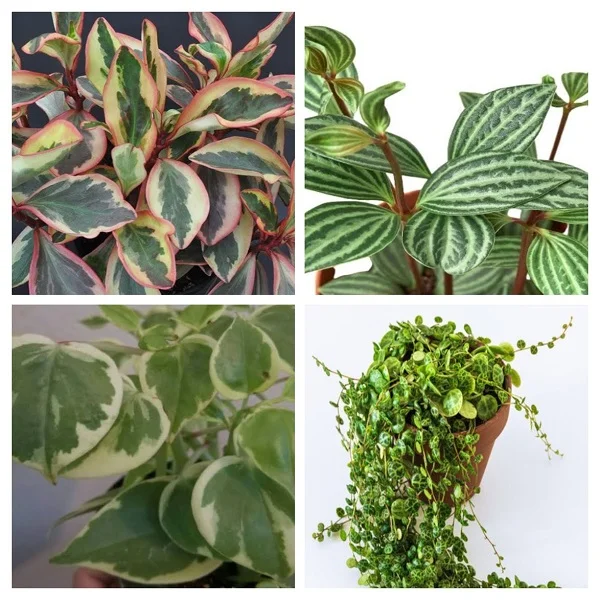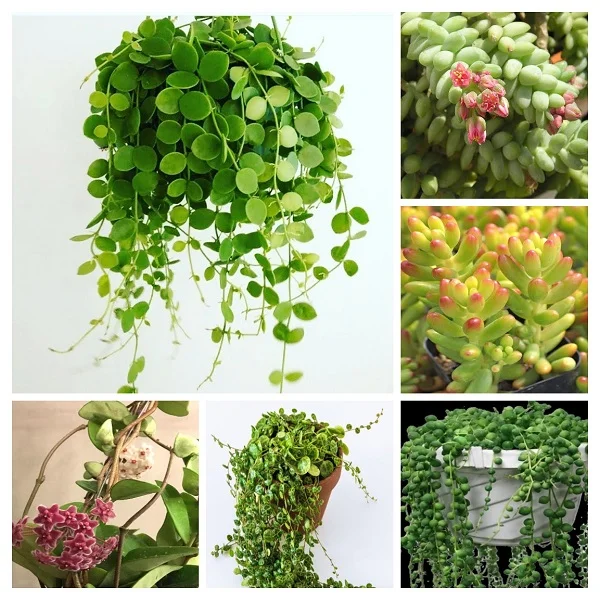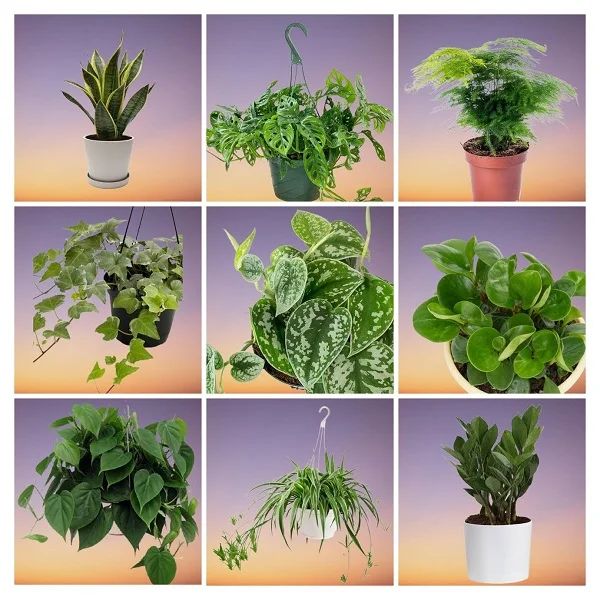Teardrop Peperomia Plant Care (Peperomia orba Care, Common Issues and Remedies
Some links in this post may be affiliate links
Teardrop Peperomia (Peperomia orba) prospers in medium to bright indirect light, warm and humid conditions and moderately moist, rich, well-drained soil coupled with monthly feeding in the growing season.
Teardrop Peperomia orba is a compact, easy-care plant which easily adapts to indoor growing conditions. In this guide, we will cover everything you need to know about caring for Peperomia Teardrop, including watering tips, ideal light conditions, propagation methods, and solutions to common problems. First, let's look at some facts about this plant.
Peperomia orba Plant among the popular Peperomia varieties and bears delicate, fleshy, dark-green, oval-shaped leaves and hence the common name, 'teardrop'.
As the plant matures, a white line appears down the center of the waxy leaves. The fleshy, red, trailing stems place this plant among the best plants for a hanging basket, tabletop, desktop or plant shelf.
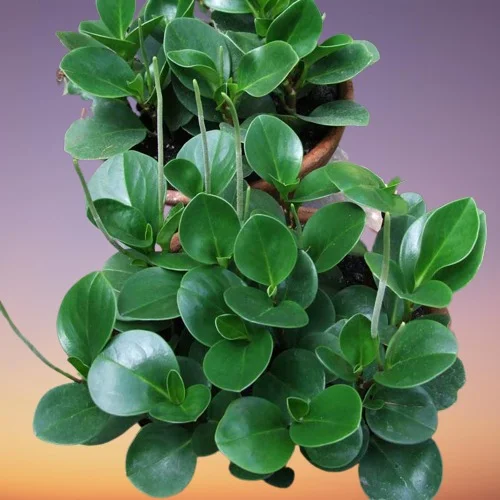
Botanical name: Peperomia orba
Family: Piperaceae
Common name: Teardrop Peperomia, Teardrop Plant, Teardrop Peperomia orba, Peperomia Teardrop Plant
Origin
Tear Peperomia Plant is native to Central and South America.
Size
Teardrop Peperomia orba is a semi-succulent, slow growing, compact plant which grows to a height of about 6 inches making this plant one of the best plants for the limited spaces in the home or office.
Flower
Teardrop Peperomia flowers are unremarkable, rat-tail flower-heads above the foliage made up of greeninsh flowers on an upright spike. The plant may not flower when grown indoors.
Varieties
Peperomia orba has many types (cultivars) which include 'Variegata', 'Pixie', 'Pixie Green', 'Pixie Lime' among others.
Is Teardrop Peperomia toxic to pets?
Teardrop Peperomia like other Peperomia Plants is non-toxic to humans and pets as stated by Leaf and Paw website. They are non-toxic to cats and are placed among the pet-safe plants perfect for growing indoors.
How do you care for Teardrop Plant indoors
To care for Teardrop Peperomia Plant give it medium to bright indirect light, average warmth of 15-260C, humidity of 60-75% and moderately moist, fertile, well-drained, succulents potting soil coupled with monthly feeding during the growing season.
Peperomia orba care requires regular pruning to keep it neat, minimize pest and disease infestations as well as encourage a bushy growth. Repotting is only needed when the plant becomes extremely pot-bound. Keep reading for more on these growing conditions and how to achieve them.
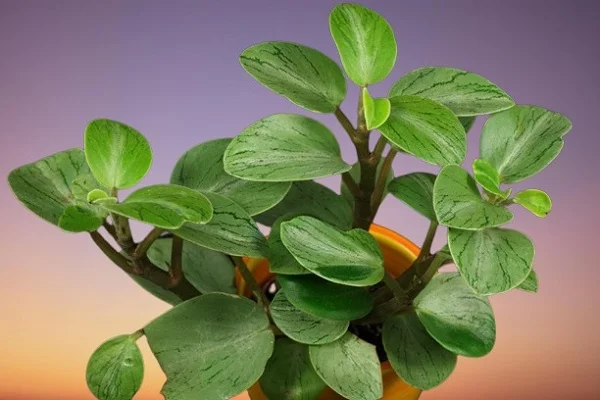
Watering
How often should I water a Teardrop Plant
Do not water your Teardrop Plant on a schedulle to avoid either overwatering or underwatering, both of which will affect growth adversely.
Water your Teardrop Peperomia Plant liberally in spring and summer and allow the top 2-3 inches of soil to dry out between waterings. Keep the soil moderately moist but not soggy to avoid yellowing leaves and rotting stems.
Reduce watering in fall and winter to keep the soil barely moist as growth is minimal at this time. Do not allow the soil to dry out completely as it may lead to wilting and drooping leaves.
Make sure that the pot has a drainage hole to prevent the soil from getting soggy as it can result in root-rot.
Take care not to wet the foliage as it can increase occurence of leaf spot disease. You may water the plant from the bottom instead.
Light Requirements
How much light does a Teardrop Peperomia need?
Teardrop Peperomia Plant grows best in medium to bright indirect light (filtered light). Keep it away from direct sunlight as it can cause scorching and drooping leaves.
Too little light may result in leggy plants and yellow leaves therefore ensure it receives adequate light. If the natural light in your home is not adequate, instal a grow light to supplement it.
Rotate the pot every so often to ensure that the plant receives light on all sides for even growth as well as prevent legginess.
Temperature and Humidity
Teardrop Peperomia orba requires an average warmth of 15-260C to thrive. Keep it away from drafts as they can result in extreme temperatures. Too high temperatures can lead to stunted growth, wilting, drooping leaves. Too low temperatures can cause reduced growth, leaf drop and brown leaf tips and edges.
Peperomia orba Plant thrives in a humidity of 60-75%. Too low humidity will result in brown leaf tips and edges. To elevate humidity, set the pot on a wet pebble tray or grow the plant in a well-lit bathroom or in a closed terrarium.
Ensure that there is good air circulation for your plant to minimize leaf spot disease which is indicated by brown leaf spots.
On account of its compact size and affinity for a warm, humid environment, Peperomia Teardrop Plant is one of the best plants for a closed terrarium as these conditions can be maintained inside a terrarium.
Fertilizer
Feed your Peperomia orba Plant with a balanced, liquid fertilizer every 4 weeks in spring and summer for a lush growth. Too much fertilizer may result in leggy growth.
Withhold feeding in fall and winter as growth is reduced and feeding at this time may lead to fertilizer burn; wilting, drooping, yellowing leaves.
Potting Soil
What kind of soil does Teardrop Peperomia like?
The best soil for Teardrop Peperomia is a loose, well-drained soil that is rich in organic matter to prevent it from getting soggy while providing the required nutrients. Being a semi-succulent plant, cactus and succulents mix is the best choice for this plant.
Repotting
Repot your Teardrop Peperomia Plant during the growing season only when the plant has become extremely pot-bound as it grows best when the roots are restricted.
Use a pot one size larger and ensure that the pot has a drainage hole to prevent the soil from getting soggy which can lead to root-rot. Check out these pots with multi Mesh drainage holes on Amazon.
Pruning & Maintenance
Pruning Peperomia orba Plant involves:
- Regular removal of dead foliage to maintain the plant neat and tidy as well as minimize pest and disease infestations.
- Cutting back the leggy stems during the growing season to rejuvenate growth as the plant becomes straggly with age.
Clean the leaves regularly by damp-wiping with a soft cloth to get rid of dust and also discourage pest and disease infestations.
Propagation
Teardrop Peperomia propagation can be done in at the beginning of the growing season from leaf-cuttings, from stem-cuttings or by plant division. The cuttings root easily and there is no need for a rooting hormone.
Learn how to propagate Teardrop Peperomia Plant in 5 easy ways.
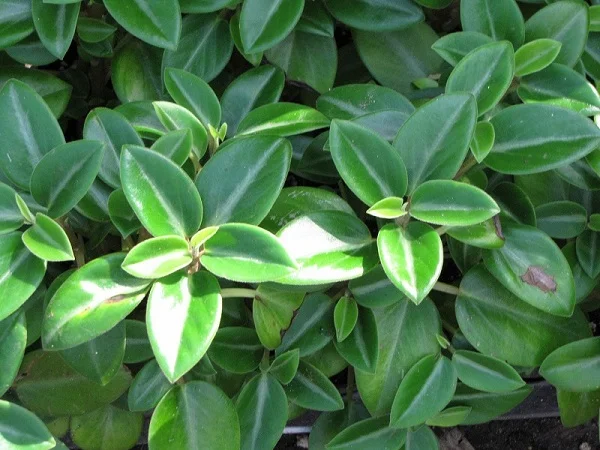
Teardrop Peperomia Plant Problems & Remedies
Peperomia orba (Teardrop Peperomia) problems are dropping leaves, drooping leaves, yellow leaves, plant dying, brown leaf spots, leggy stems, brown leaf tips, shrivelled leaves, diseases and pests among others. Keep reading for more on these problems and how to fix them.
Dropping leaves
Why are the leaves dropping on my Teardrop Peperomia?
The leaves on your Teardrop Peperomia are dropping due to too low temperature and underwatering.
How to fix it
Too low temperature: Move the plant to a warmer spot away from cold drafts and maintain an average warmth of 15-260C.
Underwatering: Water the plant when the top 2-3 inches of soil dry out. Do not let the soil dry out completely.
Take a look at these 12 reasons why Peperomia Plant is dropping leaves and solutions.
Yellow leaves
Some of the causes of yellow leaves on Teardrop Peperomia are too little light, overwatering, and underfeeding.
How to fix it
Too little light: Move the plant to a brighter spot or consider investing in grow lights.
Overwatering: Do not water on a schedule. Water when the top 2-3 inches of soil feel dry.
Underfeeding: Feed the plant with a balanced, liquid fertilizer every 4 weeks in the growing period.
Drooping leaves
Drooping leaves in Teardrop Peperomia Plant are caused by cultural faults like hot direct sunlight, underwatering, overwatering, extreme temperatures, poor feeding, pests and diseases among others.
Read more on these 14 reasons Peperomia Plant leaves are drooping and their fixes.
Plant dying
Teardrop Peperomia is dying due to root-rot which is enhanced by soggy soil. The disease is characterized by yellowing and wilting of the leaves which is rapidly followed by browning and plant collapse.
How to revive it
- Slip the plant out of its pot and inspect the roots.
- Trim brown-black mushy roots and treat the healthy roots with a copper-based fungicidal solution as recommended by the manufacturer.
- Disinfect the pot with the fungicidal solution or use a fresh pot to repot the plant in fresh well-draining soil.
- Do not water the plant immediately and keep it dry for 5-7 days before you resume watering.
- To prevent root-rot in the future, use a pot that has a drainage hole and well-draining soil to avoid getting soggy soil.
- Minimize watering in fall and winter as growth is minimal at this time; maintain the soil slightly moist.
Brown leaf spots
Brown leaf spots in Teardrop Peperomia orba are an indication of leaf spot disease. The disease is is characterized by brown, moist spots on the leaves. In a serious attack the spots can enlarge and merge, killing the whole leaf.
How to fix it
- Remove and burn the affected parts to reduce the risk of spread to the rest of the plants.
- Isolate the affected plant and spray it with a systemic fungicide as directed by the manufacturer. Ensure to cover all the parts completely.
- Keep the plant on the dry side and avoid wetting the foliage during watering and water from the bottom instead.
- Maintain good air flow for the plant to discourage the disease infestation.
Leggy stems
Leggy stems in Teardrop Peperomia are due to low light. Cutback the stems to rejuvenate growth. Position the plant in a brighter spot or instal a grow light if the natural light is not adequate.
Brown leaf tips and edges
Brown leaf tips and edges in Teardrop Peperomia are due to cold drafts. Remove all the damaged leaves. Keep the plant away from cold drafts and maintain a warmth of 15-260C.
Brown, shrivelled leaves
Brown and shrivelled leaves on Peperomia orba are caused by too dry air. Set the pot on a wet pebble tray or use a cool mist humidifier to increase humidity. You may also grow the plant in a terrarium or in the moist areas in the home.
Dry, shrivelled leaves
Excess soluble salts in the soil from the water or excess feeding are the causes of dry shrivelled leaves in Teardrop Peperomia. Flush out the salts from the soil regularly by running a stream of water through the soil until it comes out through the drainage holes.
Pests
Teardrop Peperomia is prone to spider mites, whiteflies, scale insects and mealybugs. Isolate the affected plant to prevent spread to other plants and and treat it with insecticidal soap as per the manufacturer's instructions.
Conclusion
Peperomia orba is a low-maintenance, pet-safe houseplant that thrives with moderate watering, bright indirect light, and occasional pruning. By following these care, propagation, and troubleshooting tips, your Teardrop Peperomia will stay lush and healthy for years.
You liked it? Share on social media.
Related Content
Amazon Associates Disclosure
Homeplantsguide.com is a participant in the Amazon Services LLC Associates Program, an affiliate advertising program designed to provide a means for sites to earn advertising fees by advertising and linking to amazon.com.



